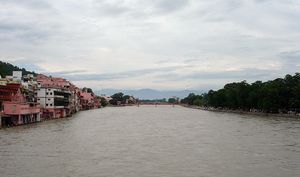 Image via Wikipedia
Image via WikipediaThe proposal has been submitted by the Indian Institutes of Technology (IIT) to the federal government on the Ganga River Basin Management Plan (GRBMP) to clean up the river in the next 12-18 months.
The final plan is expected to be finalised next month.
This will be a first time that the IITs will take part in research to save the polluted Ganga, the longest river in India. The project will have a budget of USD $8 billion.
The IITs move will be the third plan in the last 25 years to clean up the river, held sacred by millions of Hindus, who constitute 80 per cent of country's total population of 1.25 billion.
The first, the Ganga Action Plan was launched with much fanfare in 1985, but the project failed to bring down the river's pollution level. This was followed by the current National Ganga River Basin Authority (NGRBA), which is headed by Prime Minister Manmohan Singh. It was launched last year.
To be carried out under the government's Technology Development Mission, the IIT project will be executed in “mission mode”, India's federal Minister for Environment and Forests Jairam Ramesh.
“It was my personal initiative that germinated during an interaction I had with the heads of all the environmental engineering departments of the IITs at IIT-Mumbai on March 13,” the Hindu newspaper quoted the minister as saying.
He added that he expected the project would build human resources in this area in the IITs. “The next generation of water resources experts should be developed through this project. That is why I preferred going to the IIT Consortium rather than to a consulting company, which was the original plan,” Ramesh said.
The GRBMP would be comprehensive and look at socio-cultural, legislative, economic and institutional capacity building and public participation aspects.
The seven IITs involved in the project are located in Kanpur, Bombay, Delhi, Madras, Kharagpur, Guwahati, IIT-Roorkee.
The IIT-Kanpur Director, Sanjay Govind Dhande, has been appointed the coordinator between the ministry and IITs. Vinod Tare, professor in the Civil Engineering Department of IIT-Kanpur, has been named convenor for the project..
The proposal stated it would focus on the “maintenance and restoration of wholesomeness of the Ganga system and improvement of its ecological health with due regard to conflict of interest in water uses in the entire river basin.”
The plan will aim to bring down the pollution considerably in the next 10 years.
The IITs has said that they would not be the implementing agency for the project. But only prepare the work policy for NGRBA, and will be executed by various government and private organizations.
This study is different from the earlier two phases of Ganga Action Plan (GAP). It proposes a basin-wise approach for cleaning up and restoring the river, as opposed to the city-wise approach adopted in GAP.
"Basin has its own capacities for water and it will help the scientists in throwing up the best possible and suited plan," Tare has been quoted as saying by the local media.
"Scientists will study water resource management, geomorphology, eco-bio diversity, impact of dams, pollution, sources. In a nutshell, not a single angle will be skipped," he explained.
The World Bank last December announced a soft loan of USD $1 billion in the next 5 to 7 years for the NGRBA to clean and conserve River Ganges.
The clean up of the river, that starts its journey from the Himalayas and ends in the Bay of Bengal in eastern India after traversing through the major part of the country, is held sacred by millions of Hindus, who constitute 80 per cent of country's total population of over 1.25 billion.
The bank's exposure would constitute about 25 per cent of $ 4 billion plan drawn up to stop discharge of effluents and comprehensive clean up of the national river by 2020. Funds for the river cleanup may be distributed in tranches beginning last quarter of 2011.
The Ganges, which is reverently called Ganga in India, has sustained civilizations throughout time, but is today burdened by pollution due to expanding production, industries and urban development along its banks and in its basin. .
Of the major rivers in India, the River Ganges, has the longest stretch and is also the most polluted in terms of biochemical oxygen demand (BOD) load.
The river begins at the Gangotri glacier in Uttarakhand, in the central Himalayas, and drains into the Bay of Bengal through its vast delta in the Sunderbans in West Bengal state..
Almost 95 per cent of the pollution in the river is caused by sewers and open drains bringing pollutants in domestic and municipal limits fall directly into the river along its way, while only five per cent is by the direct users like households.
Scientists also say that despite hundreds of millions of Indian rupees being spent to clean the river, pollution levels in the river have reached septic levels at certain points with dissolved oxygen dropping to alarmingly low levels.

No comments:
Post a Comment